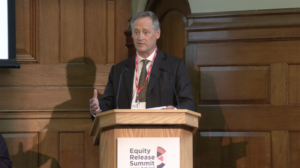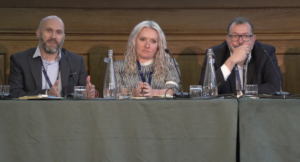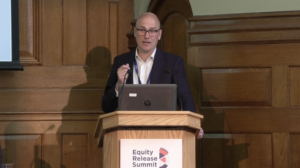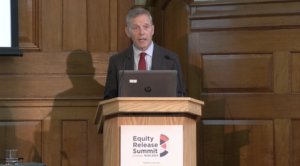The European Pensions and Property Asset Release Group, EPPARG, hosted a panel discussion highlighting Global Perspectives and Opportunities at the Equity Release Summit held at Church House in Westminster on 23 May 2024.
The session, chaired by EPPARG’s Head of Secretariat Samantha Seewoosurrun, explored the key findings of the Global Equity Release Roundtable 2023 Survey Report, which was conducted through a collaboration between EPPARG and EY, and which was formally launched on the same day.
An overview of the report was provided by Ben Grainger, Partner at EY, with panel members including EPPARG’s Deputy Secretary General Lennart Grabe and EPPARG members Robert Majkowski from FHD in Poland and Claudio Pacella from 65 Plus – Moltiply Group in Italy.
Key findings from the Global Survey
The purpose of the Global Survey, which was first conducted in 2020, was to gather information from across the 13 participating countries with two key objectives in mind. Introducing the survey, Ben Grainger explained that one goal was to “understand where firms are facing similar challenges in different countries around the world,” and encouraging these countries to work together to overcome these problems. Additionally, the survey was a means of comparing and contrasting the equity release products and “the way firms interact with their customers so they can learn from each other,” he noted.
Turning to potential growth forecasts, Ben underlined that across the 13 countries, new originations currently amounted to slightly less than $20 billion per year, while “the potential predicted by the participants is that the market could grow more than threefold to $60 billion in the next 10 years.”

Looking back at the practice not only in the UK, but in other markets, may help to rationalise the survey’s predicted growth of equity release origination volumes, noted Ben. He explained: “We have the same demographic problems in the UK, and equity release is a possible solution. The UK has the same large amount of property wealth held in older populations.”
In fact, the survey estimated that, across the participating countries, $23 trillion of property is held by over 60s. He considered that it didn’t seem hard to get all of those countries to a $2 billion or $3 billion market. Ben concluded that the survey “reiterates that there’s a lot of potential for growth and a lot of potential to support individuals in retirement around the world in this (equity release) market.”
The survey highlights that there is no “one-size-fits-all” solution for the way markets are put together around the world, as well as differences in the funding landscape. It underscores some of the differences “in many countries that operate equity release as a home reversion product, which is a property purchase rather than a loan, versus a lifetime mortgage, which is more popular in the UK,” Ben pointed out.
Ben also noted that there are countries where the interest rate on lifetime mortgages is fixed and in others it is variable, which is another example of differences in the markets. The way equity is released can also vary, “both within home reversions and equity release mortgages across the country, with lump sums tending to be the most popular. But also, a lot of cash is released through drawdown facilities like you see in the UK,” Ben Grainger said.
A lack of funding, Ben explained, commonly limits growth in equity release markets. More specifically, “a lack of suitable funding that allows you to develop the products that customers want.” Interest rates are another factor, he observed, that restricts market growth, but the report found that “customer perception and customer knowledge, and awareness of the product” were the main barrier to growth in markets. These factors are not easy to resolve, Ben summed up.
Sharing experience from the Swedish market and the benefits of high-quality international standards
Lennart Grabe, the Deputy Secretary General of EPPARG, explained that although elderly populations are increasing, and modern healthcare can preserve the elderly’s quality of life for longer, “no pension system seems to exist” to adequately fund the active lifestyle they still want to enjoy.
Lennart introduced equity release in Sweden over 20 years ago, when he chose to implement lifetime mortgages. “It was of paramount importance that I could prove that it was a serious, well thought through product with ambitious standards for consumer protection,” he said. Lennart designed his product and marketing activities in line with the Safe Home Income Plan standards used in the UK.

These SHIP standards eventually became the Equity Release Council standards, which Lennart described as a “very good role model for us all”, to this day. Having applied the SHIP standards to it, the equity release product introduced by Lennart dominated the Swedish market in view of its No Negative Equity Guarantee – in other words, prioritising the needs of consumers.
”We defined the business that has prevailed in the Swedish market,” he said. When EPPARG was founded, representatives from other countries “all had strikingly similar experiences. We soon realised the benefits of sharing experiences,” at which point EPPARG agreed to a “common, pan-European standard for all countries” that would ensure a safe market for both consumers and investors.
“Well proven pan-European standards give industry strong arguments in dialogue with rule makers in seeing to it that local legislation and regulation does not hinder or hamper this business,” Lennart proclaimed. Conversely, “a common standard also makes it possible to develop cross-border business,” noting that this brings benefits in funding, marketing as well as building volume. Pan-European standards give equity release products more credibility and a better reputation, he explained.
Protecting the customer in the Polish home reversion market
Robert Majkowski, CEO of FHD from Poland, explained how Poland transitioned from socialist to capitalist economics after observing that capitalism has been successful in Western Europe. Robert described Poland adopting capitalism as “a huge movement for our nation”.
Similarly, he continued: “What we also did in the home reversion and lifetime mortgage product was we have started to learn. Learn from more developed markets what to do, and how to create the market which was not existing, but which had started to grow quite quickly.” The code of conduct Poland uses for equity products today was inspired by the SHIP, now Equity Release Council, standards that many European countries followed.

As a result, Polish markets “started to share the same impression that we have to take care of the client, the customer. The customer should be our main focus and we should protect the client to protect the market,” Robert highlighted. “Our way of thinking is almost the same,” he said, but noted that Polish markets do face the same hindrances to growth as other European markets do.
Robert boldly stated: “I believe personally that equity release should be a piece of the puzzle for pension schemes across all of Europe.” Sharing the same product standards and the same mission with the rest of Europe would only further enhance consumer protection, Robert suggested. However, because of funding constraints, Polish banks are reluctant to offer lifetime mortgages, but Robert stated that there is “great potential” in Poland’s equity release markets in the near future.
Facing funding challenges in Italy
Explaining the market situation in Italy, Claudio Pacella, CEO of 65 Plus – Moltiply Group, in Italy, explained that: “The problem that we had was not the potential of the market, it was not the regulation, it was the funding.”
“We started our experience as advisor and servicer,” he said, and the funding initially came from Italy’s banks. “Our idea was to help originating little portfolios of equity release mortgages in each bank,” which he hoped would lead to a relevant volume for the market. However, this approach did not help to move the market, due to capital requirements and “an asset and liability management that looked unusual according to banks’ experience”. Moreover, “cash flows’ modelling and interest rate swaps depend on actuarial know-how which is not common in the banking framework,” he noted. Finally, banks didn’t offer an ‘interest only’ version either, Claudio underlined.

To resolve their funding issue, “we tried to step back from banks, and we started talking to pension funds,” Claudio explained. He cited Italy’s already existing pension funds for professionals “such as lawyers, notaries, and so on.” However, “even if the asset was perfectly fitting their needs, they needed an established market with high volumes to start investing at industrial scale”.
Upon concluding that funding constraints in Italy were too tight, “we had the fortune of joining and contributing to the founding of EPPARG, with whom we shared standards, experiences and know-how” as well funding projects, Claudio explained. “The last piece of the puzzle was the funding,” he added, which has now allowed Italy to offer “an open market product that is our own, as well as that of some of our friends in EPPARG.”
It took two years, but now funding is allowing Italy to successfully create an origination platform; Claudio compared the process to share funding from the UK to “the opposite of Brexit – this was continental Europe wanting to enter the funding of the UK”. He described the funding project as a successful start-up and hoped that it would be “a very successful development for all the participants.”

Winding up the discussion, Samantha Seewoosurrun thanked the four panelists for their contributions to the panel session before taking some questions from the floor. She invited the audience to follow EPPARG’s website and social media channels to keep up to date with its activities.

London, 20 March 2024: The European Pensions and Property Asset Release Group (EPPARG) and EY have today published the Global Equity Release Roundtable 2023 survey report, which highlights that the global equity release market could hit USD 50 billion by 2033, more than doubling its current size.
The report gathers data from market leaders across 13 countries globally with established or developing equity release markets, and analyses growth potential. The 13 countries span Europe, North America and Australia, and are considered to be amongst the largest equity release markets in the world.
Key findings from the report include:
- There is an increasing need for the product given the cost of living crisis and higher inflation.
- Among the countries analysed, over $17bn of equity is currently released each year for homeowners, but this is expected to increase dramatically by 2033, when the global equity release market is expected to reach $50bn in annual releases.
- Banks are the most common source of financing for equity release mortgages globally, followed by insurance companies, securitisations and debt.
- The most common type of equity release is the lifetime mortgage, which is available in the majority of countries covered by the survey, followed by home reversion schemes.
- Equity release products are typically available to customers from the age of 55 or 60 years old, with a mix of fixed and variable rates offered.
- The most popular product globally is the lump sum, with annuity and drawdown products available in a number of countries.
- The most significant factor cited as impacting equity release pricing is interest rates, followed by funding costs and availability.
- A lack of customer awareness is cited as the primary barrier to growth, followed by insufficient funding, notably in European markets.
Commenting on the survey findings, Steve Kyle, Secretary General of EPPARG, said:
“We are very much encouraged by the results of our latest survey, which confirms that equity release has an increasing role to play at global level in allowing elderly homeowners to draw on their own home as an asset to finance a decent and comfortable retirement. We will be continuing to build awareness of equity release products internationally in view of the significant social and economic benefits that they bring. In Europe, I am pleased to say that we are seeing a number of new innovative start-ups entering the market, which is still nascent in some countries, with a range of business models designed to offer new financing options to elderly homeowners.”
“At EPPARG, we also advocate a clear focus on ensuring high standards, such as our own EPPARG 10 standards in Europe, for both lifetime mortgages and home reversion products. Our goal is to foster an enabling environment which will allow the global equity release market to reach its full potential, as a safe and attractive option for investors and elderly homeowners alike.”
Ben Grainger, Partner at EY, said:
“Supporting growth in the global equity release market has the potential to transform thousands of people’s retirements, and it is positive to see such strong momentum currently.”
“Unlocking the global potential further will require deeper cross-border collaboration, achieved by sharing funding models, sources and best practice customer standards. Progress is happening, and we look forward to working with our clients around the world to grow and develop this market.”
Steve Irwin, President of the National Reverse Mortgage Lenders Association (NRMLA) of the USA said:
“Housing wealth remains one of the greatest assets for the vast majority of the ever-increasing global population of older homeowners, and the ability to access that equity, under the right circumstances, is the key to enabling a more secure retirement. As this marketplace expands and matures, which is clearly anticipated by the marketplace study, it will be necessary for participants to ensure consumer protections and education remain as a solid foundation of the product offerings.”
David Burrowes, Chairman of the UK Equity Release Council and EPPARG Board Member, said:
“This survey resonates with the Council’s understanding that growth of the market and unlocking property wealth to support the growing needs of later life consumers’ needs greater customer awareness. Maintaining and increasing consumer confidence needs to be based on standards and innovation which support good consumer outcomes.
The survey report is available here:
https://epparg.org/wp-content/uploads/2024/03/FINAL_EYGEN_2023_Global_ERM_Survey-FV.pdf
The report is based on data collected from equity release market players in the following 13 countries: Australia, Canada, France, Germany, Italy, Ireland, the Netherlands, Norway, Poland, Spain, Sweden, the UK and the USA.
Claudio Pacella, CEO of 65Plus – Gruppo Mutuionline in Italy and an EPPARG Board Member, explains how the signature of the first funding agreement between Centro Finanziamenti and international investors represents a game-changer for the Italian market, with an estimated overall market opportunity in excess of €2 billion.
How would you describe the shape of the equity release market in Italy at the beginning of 2024?
It is very important to distinguish between the vision we may have of the “historical” market of lifetime mortgages and its prospective vision. In fact, Centro Finanziamenti signed the first funding agreement with international investors; this is going to be a “game-changer” for the Italian market, since a lack of funding has always been the real bottleneck.
This is why 2024 is going to be a turning point and a strong discontinuity with the past: Centro Finanziamenti’s new lifetime mortgage is landing in the market as the first “open market” product, offered through third-party networks such as banks, financial companies, networks of agents and brokers. For some partners, a “white label” version will also be offered, which allows for the customization of the entire marketing and communication phase. These aspects are turning a small “multi-captive” market into a fully open market that now can fulfil the real market potential for volumes.
What has been the impact of the challenging global economic context on the Italian equity release market? Are you seeing some particular trends?
The global environment in 2023, with an unprecedented increase in financial rates, slowed down all credit volumes, including lifetime mortgages; therefore, lifetime mortgages have also been negatively impacted. However, looking ahead to 2024, a substantial stability in rates is expected together with the beginning of a material reduction: this also will help in adding a positive momentum to the market.
How do you see the current demand for equity release products in Italy and how can this be stimulated further? What is the role to be played by distributors, commercial banks, consumer associations or other organisations in building awareness and understanding of the product?
The demand for lifetime mortgages remains very high, similar to the UK market, although it is currently unexpressed. To this end, the role of distributors is a key element to increase the visibility of the product; we do not expect to see highly visible retail communication campaigns (B2C). For this reason, the role of distributors in peer-to-peer communication with customers becomes a key element. We have heavily invested in training and monitoring distribution networks and therefore we are confident that the process will proceed smoothly.
What more can be done to encourage investors to take a greater interest in funding equity release in Italy? How would you describe the market potential in Italy, in view of the ageing population?
The Italian market is undoubtedly one of the most interesting in the European context: high population density, the highest average age in Europe, a non-volatile real estate market, regulations consolidated in the last 15 years and no negative events in reputational terms. For all these reasons, the market to be seized in Italy is in excess of €2 billion. The best communication to investors will be the actual results of this new “open market”. Also for investors, the first mover will have an undoubted competitive advantage.
What are your predictions regarding the prospects for the equity release market in Italy in 2024?
Centro Finanziamenti and 65Plus leading this change in the market will accelerate the whole longevity economy sector. The more visible side will be the distribution front, while there a centralized management, for the first time, will enhance adequate economies of scale.
Thomas Bodereau, Co-Founder and CFO of French lifetime mortgage provider Arrago, describes the company’s journey to date and shares his perspective on prospects for growth in the French market, in view of the ageing demographics and high home ownership rate.
What was the rationale behind the creation of Arrago back in 2017? What potential did you see for the lifetime mortgage market to develop and what has been your experience since then?
Arrago has already had ‘two lives’. In 2017 we were a private debt broker specialized in sourcing performing private debt from 2nd and 3rd tier French banks’ balance sheets. Those private debts were sold through a call-for-tender process to various asset managers, insurance companies or banks across Europe. We had sold around EUR 600 million of those private debt, especially long duration ones.
We held a specific discussion with British investors about lifetime mortgages as a very interesting asset class. It appeared that we knew very well the French lifetime mortgage because Arrago’s team is composed of three former Crédit Foncier de France (“CFF”) officers, and CFF had been the only bank which was very active in the realm of such mortgages in France.
Thus, in late 2019, we kickstarted Arrago’s ‘second life’ by deciding to move forward and develop such an offer in France. We were convinced of the benefits for the French people as they were only served through home reversion (known as “viager”) which is not a mass market product.
In 2022, our endeavours led us to raise EUR 5m in equity and EUR 50m of debt to start providing lifetime mortgages. We launched our offer in March 2023 with a French retail bank.
What potential did you see for the lifetime mortgage market to develop and what has been your experience since then?
Demographics in France are similar to those of the UK, with a similar rate of ownership by elderly people. We foresee a potential equivalent lifetime mortgage market in France to that of the UK. Home reversion represents only 5,500 transactions but in my view lifetime mortgages are a much broader product and could be ten times bigger. However, people in France are not currently much aware of lifetime mortgages because the offer has been very limited so far. The aim is to build wider awareness and familiarity with the product.
2023 was our first year, where we were active for just 10 months. We have assembled a full team of 11 employees to achieve a complete operational base and are already the leader in the market with EUR 10m originated. We already have much bigger figures in our business pipeline for 2024.
How would you describe the current market for equity release in France?
The market for equity release in France is currently very tiny since there was hardly any offer, but we know that several banks and fintechs are looking at this area closely. For banks the market is small and in its nascent stage as compared to their more established forms of lending (consumer loans and real estate loans).
What sales channels are available in France?
In France equity release products can be sold by retail banks, brokers, and promoted by business introducers such as home reversion providers, realtors, companies offering products or services tailored to the over-60s, and insurance companies having elderly people as clients.
How are lifetime mortgages used in France to supplement the income of elderly homeowners? What are the primary uses of the product?
While on average France pensions are rather high as compared to some other European countries, they are under pressure and have been impacted by recent inflation. Our customers mainly use the proceeds to refurbish their homes, offset pensions which may be declining in value in view of high inflation, make gifts to their family and early repayments on existing amortizing loans.
What opportunities do you see for new funders and investors to enter the French market?
France is potentially the biggest market in continental Europe for two reasons:
- Very supportive demographics
- Home ownership rate above 70%
Regarding funders, established players from the British market and French insurance companies have a fantastic opportunity to enter a market in its early stage and under rather promising conditions.
Pierre Cornet-Vernet, Co-Founder and CEO of Jubilé from France, explains the company’s mission to empower the elderly in France, where over 70% of senior citizens own their primary residence and are increasingly in need of financial solutions.
Can you tell us about the rationale for the creation of Jubilé, as a French start-up established in 2021, against a backdrop of changing dynamics in the French equity release market in recent years?
We began with a straightforward observation: currently, the elderly in France have limited options for financial solutions, particularly ethical ones. Banks predominantly lend to young, healthy individuals employed on permanent contracts. However, the financial needs of our seniors are substantial. They require funds for home improvements and modifications, ongoing home maintenance, healthy ageing, costs of dependency, and providing intergenerational support. Access to credit is a critical issue for them and their families, representing a broader societal challenge.
Another key observation is that over 70% of seniors in France own their primary residence, which translates to more than 10 million individuals. What are their options? Mostly, they have none. The typical solution involves selling their home, either outright or through a life annuity. While this approach addresses some needs, it’s far from ideal. We believe we can do better, particularly by keeping the property and its potential future value within the family.
In our search for a solution to finance our parents’ needs, we explored various options. We discovered that the consumer code already includes a law for exactly this purpose: the reverse mortgage (or “prêt viager hypothécaire” in French). Defined with precision by the consumer code since 2006, the maturity of a reverse mortgage is linked to the borrower’s estate, the sale of the property, or it can be settled early at the borrower’s discretion. Moreover, this type of loan, being zero coupon, does not strain the already tight monthly budgets of seniors.
However, today, almost no bank offers this service. That’s where Jubilé steps in, offering a new financial solution for our elderly. We are dedicated to empowering the elderly, ensuring their financial stability, and recognizing their invaluable contributions. It is our mission, our ‘raison d’être’.
How would you describe the current position of the equity release market in France, at the end of 2023? What types of products are available on the French market? What are the main sales channels used to reach potential customers?
The equity release market in France is still almost non-existent. It is beginning to develop, primarily through small startups like ours, as well as some initiatives from a major bank. However, amidst growing inflation, decreasing pensions, and the rising cost of living, our senior population is increasingly in need of financial solutions.
Despite its underdevelopment, seniors have alternative ways to leverage their real estate assets. These include the life-annuity sale, known locally as “viager”, and the sale of bare ownership, or sale of “nue-propriété” in French. While these methods can provide financial relief in later life, they also involve selling and losing ownership, which may not be feasible for everyone.
We anticipate that the market will begin to attract more attention next year. The launch of Jubilé should contribute significantly to this increased interest!
Regarding sales channels, the field is relatively narrow so far.
How do you see the level of consumer awareness of equity release options in France? What are some of the main uses of equity release products in France? What trends are you seeing currently?
In France, the concept of reverse mortgages is still relatively unknown, especially compared to countries like the USA or the UK. Despite being available in the French law for some time, there is a noticeable lack of consumer awareness and understanding. This may be partly due to the limited offers at this stage.
We launched our digital platform in 2023, and to date, a significant portion of our demand stems from unforeseen expenses such as home renovations and maintenance. Costs related to ageing is a strong driver as well.
Regarding current trends, the market is still evolving, but recent efforts are focused on revitalizing and securing this type of loan. Nonetheless, the high cost of reverse mortgages continues to be a significant obstacle to wider acceptance. There are ongoing efforts to reduce these costs and enhance the appeal of the product.

How do you see the appetite of investors for moving into the equity release space in France, and how can this be further stimulated?
The reverse mortgage market in France is currently viewed as a specialized sector, characterized by a cautious approach to investment. This caution stems from the product’s complexity, concerns regarding the age of borrowers, the unique regulatory landscape, and compounding interest. It doesn’t fit in any traditional investment category.
Despite these challenges, there is significant potential for growth, especially considering the ageing population and the important rate of property ownership among seniors.
Many major financial institutions are demonstrating a willingness to assist their elderly clients and could potentially consider this excellent product.
To stimulate investor interest, clear and favorable regulations are essential to encourage investment in this sector. Potential measures could include guarantees to mitigate perceived risks, or reduction of capital requirement for banks on the product. Furthermore, collaboration with banks and other financial institutions is crucial for integrating reverse mortgages into broader retirement planning strategies.
Looking ahead, what are your plans for Jubilé in 2024? How do you see prospects for growth across the French market more broadly?
Regarding Jubilé, we are gearing up to embark on our journey in Q1 2024 with a major French bank through a pilot project across several regions in France.
So far, we believe that in France, the issue is more about a shortage of quality offerings than a lack of demand
However, lack of awareness and understanding of reverse mortgages among the general public is quite a hurdle. To tackle this, dedicated efforts towards education and awareness-raising are essential. By effectively communicating the benefits and protections that reverse mortgages provide to borrowers and their heirs, we can foster greater interest and demand for these financial products. This strategy not only addresses the immediate financial needs of seniors but also contributes to creating a more informed and empowered group of consumers.

The importance of understanding ageing customers and their needs was the focus of a plenary session held at the UK’s Equity Release Summit held on 16 May 2023.
The session explored the vulnerabilities of the sector’s consumers, addressed the industry’s responsibilities in supporting these consumers in later life, and stressed upon the innovation required to ensure the continued stewardship of consumer safeguards. The panel was led by consumer champion and commentator, James Daley, founder and MD of Fairer Finance; and counted stellar speakers such as Mike Ellicock, Co-Founder & Chief Executive, Plain Numbers; Richard Lane, Director of External Affairs & Operating Subsidiaries, StepChange; Chris Pond, Chair, Financial Inclusion Commission and Lyndsey Fallon, Partner, Deloitte.
Jim Boyd, CEO of the Equity Release Council, launched the panel discussion by requesting Jeff Prestridge, Group Wealth & Personal Finance Editor of Daily Mail and General Trust (DMGT), to deliver the keynote address. A consumer campaigner and a newspaper finance journalist for over 25 years, Jeff has been a major commentator in helping consumers make more informed decisions.

Jeff Prestridge started by emphasising that the 350 delegates present reflected the importance of the Equity Release Council (ERC), with the equity release market sure to grow as elderly people continued to use their homes to release much needed liquidity.
“Times are going to remain tough for quite a while and equity release will provide a financial solution. At the ERC, your key role in raising standards means we now have an equity release market which is fit for purpose. Yet, there is no room for complacency. It is vital that the consumer comes first and is at the heart of everything you do – yes, the FCA is imposing consumer duties on you – but serving the best needs of consumers should be built into your DNA,” he highlighted.
He noted that the equity release industry at inception had promoted certain schemes, involving the use of customer bonds, that were nothing short of calamitous, with customers hit by a double whammy of falling stock markets and a stiff housing market correction. He noted that he would use his keynote address to steer the discussion away from this dark and dim past, by reflecting on what the industry should do to be fit for the future.

“The industry must remain fully focused on providing customers with transparent, value for money products underpinned by no negative equity guarantees. It must also be committed to providing stellar service, not just in the run up to the plan being purchased but during the plan’s life,” he noted. He also emphasised that equity release is not for everyone and that there are better alternatives such as retirement interest only mortgages or releasing equity through downsizing, pointing out that every sale must be underpinned by what is good for the customer, not the provider or advisor.
He noted the industry’s willingness to keep evolving and adapting, in the process making the plans far more flexible such as, the ability of plan holders to counter the impact of compound interest on their mortgages. “In 2022, equity release customers made nearly 190,000 penalty free payments, 50% up on the year before, saving nearly £ 160 mn in future interest costs. That is great for consumers and for the reputation of the equity release market. It is a double win!”
He lauded the council for wiring into its standards a requirement for all new plans to provide penalty-free, partial repayment options; extending the ability to borrow amounts under equity release plans on a piecemeal basis; building inheritance protection into plans; and the emergence of a re-mortgage market enabling borrowers to switch to cheaper plans.
“We now have more than 1,500 advisers and the industry is attracting new players, whether new advisers or funders. The more providers in the market, the more competition it will spark, and the more innovation it will lead to, in the process driving down charges,” he commented.
He noted the great progress that the industry has made in recent years with the ERC having recently put in place measures such as recommending all providers show charges and set out key information in a way that buyers can understand easily; any plan sold to show how the loan will grow over time; no plan to be sold without everyone concerned showing that they understand the impact of compound interest on the loan; and an imminent announcement that family will be given key information at key points in their equity release journey, for example, when the loved one dies or when the plan ceases.
He urged that the industry should be better at pointing out the practical uses of equity release, be it to make home improvements, to adapt homes to specific care needs or to fund at-home care, driving home three key points in conclusion:
- The industry needs to do more to educate the public with a more consumer-friendly Council website;
- As scamming is on the rise, the industry must do more to ensure consumers do not fall foul of scammers; and,
- With lending for the first quarter this year at its lowest level since the pandemic, people clearly still feel cautious about buying into a fixed rate product, hence the Council must analyse the impact of higher interest rates on the market.
Next, James Daley took over on the note that good progress had been made in just the last 3 years since he addressed the audience, and that the latest regulation on consumer duty boded well for the future.

“Consumer duty comes into force in just 11 weeks. It provides an obligation on all financial services firms not just to work towards delivering good customer outcomes but to prove that they’re doing so and to attest so at board level every year.” He summarised that it meant proving that you’re offering fair value, that you’re providing the right level of support to customers, that you have robust product governance in place and that you’re communicating with customers in a language they can understand.
He highlighted that there needs to be a clear basis for justifying product pricing, rates being what they are, and also emphasised that communications is an area where all companies, not just equity release companies, have a lot of work to do. The consumer duty now expects it of the players to simplify the technical jargon, he added.
He concluded on the note that the good news is that if the industry can meet the requirements, their interests will be much more aligned with the interests of consumers, soberingly cautioning players that ‘it takes years to build a reputation for trust and integrity and seconds to shatter it.’
James next introduced the members of the panel, first up being Mike Ellicock, co-founder and CEO of Plain Numbers, who started his career in the military, did an MBA, and ended up running a mass education business. He then founded a charity to improve numeracy across the UK which led to the creation of Plain Numbers in 2020.
Mike took to the stage to address how the industry can communicate better. He cautioned that half of adults understand as much as primary schoolchildren. He further highlighted that the issue is not just about numbers but also about attitudes – about how numbers make people feel.
“The first thing is about numbers themselves. There is plenty of evidence about how to communicate around numbers so that more people can understand. Secondly, put numbers in context – avoid three letter abbreviations and try to overcome the curse of knowledge. The third element is about behavioural science – how do we as humans think and how do we communicate with customers in a way that acknowledges their behavioural biases and their natural way of thinking,” he explained, elaborating on the Plain Numbers approach, which was trialled back in 2021 with support from the Bank of England with 5 different firms across 4 different industries, and subsequently support from the Treasury department, with the coverage now spread to 30 firms across the UK.

He also cautioned that consumer duty is a sprint to the finishing line with the real marathon yet to begin. He concluded that Plain Numbers is here to support firms to build this approach into their core framework, and that it was able to double the number of people that could understand communication coming from financial services firms.
Next up, James turned to Richard Lane, who has served as director of external affairs at the largest debt advisor in the UK, Stepchange Debt Charity, for the last 5 years, prior to which he was working in comms and marketing at national disability charity, Scope, and was working on campaigns and public affairs at the LGBT charity Stonewall.
Richard explained that StepChange has been providing debt advice and that it helps half a million people with their financial difficulties. He emphasised that the landscape in which StepChange operates has fundamentally changed through the pandemic and now the cost of living crisis meant that it is dealing with more vulnerable clients than ever before. In the past people contacted StepChange because of a life event but now it is because of the cost of living crisis, he soberingly remarked.

He rued that they are now fundamentally running out of tools to help people as individuals are contacting Stepchange with a negative budget. Ultimately, some of these changes cannot be fixed by such advisories or financial services sector but need changes in public policy – the government needs to put in place a safety net, continue energy support, and provide social tariffs, he elaborated.
“We have to find any tool that we have at our disposal to help people. Equity release absolutely, categorically has to be part of the solution. We at StepChange provide it and think it is an absolutely vital solution for some people,” he noted, while cautioning that it doesn’t mean that equity release is perfect. He soberingly noted that research shows how people are incredibly confused by the communication they receive when they are in financial difficulties, which is also a point in time that people are most reluctant to approach experts for support.
James next turned to Chris Pond, who recently ended more than a decade’s tenure as chair of the standards board for Equity Release. He has served previously as director of the FCA and is currently chair of the TrustMark Board.
Chris chose to address the audience upfront on the opportunities offered by equity release. He reflected on green finance and how people can reduce cost of living through securing energy efficiencies and also contribute to net zero targets through equity release offerings.

He highlighted that he was fascinated by the statistic that 32% of well-to-do customers of equity release have absolutely no concerns around it. However, the rise from 7% last year to 32% this year has been among the well-heeled clientele who have benefitted from the standards that have been put in place by the ERC over time.
“All the time standards evolve and change to the evolving market. As a result of the standards you have influential people like Martin Lewis or Hector Sanz stepping up to say that for some people the equity release market is all right and as long as you deal with someone from the ERC you should be ok if the circumstances are correct. However, here is the challenge. There is another cohort – the two and a quarter million more people that the FCA told us have been pushed into financial difficulties because of the pandemic, and that was even before the cost of living crisis hit,” he reflected.
He concluded on the note that, as Jeff pointed out, more and more people would be turning to equity release to supplement inadequate retirement incomes, and the challenge is that more of those people would be hailing from increasingly vulnerable backgrounds. Hence, the equity release market would need to continually adapt products, services and standards to cater for such people, he noted.
James finally asked Lyndsey Fallon, partner at Deloitte, to reflect on the concept of fair value. Lyndsey pointed out that a lot of time and investment has gone into consumer duty so far, and also into considerations needed around fair value assessment and the outputs of that. She emphasised that it has generated the right debate and discussion around interest, fees, charges and features needed to ensure that all customers are able to access the benefits from equity release, and in particular, cohorts such as vulnerable customers.

“One of key challenges for firms is the availability of data analysis to be able to demonstrate how different customers they interact with are able to access value from products such as equity release. That is going to become important moving forward as a need to show that you are offering fair value. As I reflect on a number of debates and discussions today there is a lot of talk on purpose and use cases (social care, green finance, retirement planning) but actually you really need to evidence you are reaching the right customers because that is where you will be able to demonstrate the most value from the products and services you offer,” she emphasised.
Secondly, she noted the challenge of defining the roles and responsibilities across equity release – funder, manufacturer and distributor – have regarding product design, price, fees and charges. She emphasised that consumer duty has helped shape that discussion and debate.
“If we look at what the FCA has started to say over the last week – if you have done your fair value assessment, how is that effective? This is going to move to focus on evidence and monitoring, to be able to demonstrate fair value,” she concluded.
Finally, a key audience question was posed on the issue of comparing equity release with other products such as mortgages based on the ability of customers to make monthly committed repayments vs flexible repayments as the only option in the equity release market being touted in the media.
Jeff Prestridge stated that it is all about education, and that most people in the press who consider themselves qualified to write about personal finance, understand that equity release is far more flexible than it was a decade ago, and that providers now allow customers to make part or even full monthly interest repayments. “There is an education exercise out there – people just assume with equity release that all the interest will roll up and that isn’t the case anymore. It’s a message that you need to get out as an industry and a message that people like myself and James need to beat the drum about. One of the great attributes of equity release 2023 is its far greater flexibility and consumer friendliness, so it is maybe simply a question of communication now.”
Jeff Prestridge concluded by emphasising the importance of trust and human interaction in building an equity release market that works for consumers.
“What counts is your relationship with your clients and building trust – you can’t do it on the telephone or the internet – it is all about face-to-face interaction and about coming around on an ad hoc basis to explain how the plan is progressing. That is a great advert for quality advice that we should allow to breathe in this country,” he noted.
The potential role of the UK’s £5 trillion property wealth in addressing major societal challenges facing the UK’s ageing population was the subject of a recent report commissioned by the Equity Release Council, entitled ‘Later Life Lending: Great Expectations’. The recommendations of this report were explored in a plenary session at the UK’s Equity Release Summit on 16 May.
This independent report was commissioned by the Equity Release Council earlier this year, and was published by Jon Dunckley, CEO of About Consulting Group. It was commissioned to help set out a route map for all market participants – including government, regulators, and industry – to better support the UK’s ageing population.
The report calls for coordinated action to build on recent progress to create a later life lending market which reflects consumers’ evolving needs and can support a joined-up approach to using property wealth in later life financial planning. The ultimate aim is to raise retirement living standards and equip homeowners and their families to enjoy a better quality of life.
The session was introduced by Jim Boyd, Chief Executive Officer, Equity Release Council, who explained why the report had been commissioned, and was followed by a panel chaired by Tom McPhail, Director of Public Affairs at the lang cat. The findings were discussed by a number of expert panellists, namely Jon Dunckley, CEO, About Consulting Group; Paul Broadhead, Head of Mortgages and Housing, The Building Societies Association (BSA); John Somerville, Head of Financial Services, Corporate & Professional Learning, The London Institute of Banking & Finance (LIBF) and Charlotte Allen, Chief Compliance and Risk Officer, Key Group.
The future of retirement will have to change
Introducing the session, Jim Boyd noted that in 10 years’ time one quarter of the UK’s population would be 65 or older, and that “the future of retirement will have to change” as there would be fewer working people to support an increasing share of public spending on older people.
He mentioned that he had attended a “brilliant meeting” of EPPARG members the previous evening, which brought together market players from the US, Canada, Australia and Europe, and highlighted that “the commonality of issues is what stood out. There is nothing new here. This is a global issue for advanced economies”. He asserted that “unlocking the huge reservoir of property wealth” might not be the whole solution but it would play an important part.

He highlighted that UK net property wealth is worth £5.6 trillion pounds, representing approximately £228,000 per household, and that according to Savills, over 50s own 78% of the UK’s housing stock.
In terms of equity release, since 1991, 640,000 homeowners had accessed £45 billion from Equity Release Council members, and last year the average equity release plan was worth £133,000. He saw that this could close the gap from a minimum pension for around 18 years of a moderate lifestyle. He also noted how equity release could support women, who tend to have the worst pensions, live longer by themselves and who are the least likely group of people to shop around for alternative assets. He explained that a quarter of all equity release plans taken out provide some sort of living inheritance for the next generation, which can help them to get on the housing ladder and also to support environmental improvements.
Considering that the contribution of equity release to the UK economy is “clearly significant”, Jim asked “why is it not achieving its potential?” In his view, the regulatory framework is disjointed, with mortgages and equity release subject to different regulations, with too many advisers working in silos. He saw that the UK had a department of work and pensions, but not a department of work and retirement. “If you can’t align the objectives with government in a coherent way it is impossible that those broader conversations can be understood at a higher level,” Jim underlined.
Since property – which is the biggest asset for most people – is not included, Jim urged that the government and industry should “work together to collectively agree a blueprint for the use of what housing wealth looks like in later life” and explained that this was why they had commissioned an independent report from Jon. “Every time I read about a pensioner with a house of about 300k unmortgages, struggling to make choices between heating and eating, and they haven’t considered the option of housing wealth …. I treat it as a failure,” Jim concluded.
Finding the right solutions for later life lending
The discussion was led by Tom McPhail, who noted the people who were expecting an inheritance were now mainly in their 50s and asked if that was the best point in life to receive the money. He saw that equity release could fix more problems for people and saw that there was an opportunity to stimulate economic growth. He saw that despite product innovation and standards, “we are not making a lot of headway” since it had not changed the game yet. He emphasised that “most people still have a fairly negative perception of the equity release sector” and saw that there was a gap between equity release advice and wealth management advice more broadly.

As the author of the report, Jon Dunckley, stressed the need to come up with a political consensus on the way ahead. He highlighted that the UK has got an extremely adversarial political system where “an opposition that agrees with government policy is seen as weak”. He saw that without a political consensus, “no one has the bravery to face into the really difficult challenges that we have got as a country with a policy that might have a chance of resolving it”. He described the care system in the country as “broken”, where there should be an option of making it easier for people to take care of themselves. Overall, he saw that a consensus could only be built if there was a will and support of leadership and ideas.
Paul Broadhead saw that the challenges had now evolved. He considered that for government it is easier for industry collectively to start to have discussions “rather than asking government to decide our future”. He thought there was a need to ensure people are getting the right financial solution for their circumstances at the right time. He also underlined that the mainstream and lifetime markets operate in isolation and are subject to different regulations.

John Somerville remarked that “there is an awful lot of education needs to happen in order for us to move forward” and saw that the shortage of housing was an issue. He advocated that “we have got to stop sitting in silos” and considered that “wealth advisers don’t care that much and equity release advisers need to get their point across”. He urged that the industry to “create a need that wealth advisers can’t walk past” as they could refer the customers. “If you are not talking to wealth advisers in your locality it is about educating each other,” he summed up.
Elaborating on the point of referrals, Charlotte Allen noted that the regulators were doing a lot of work on the sector and saw that “if a customer can afford to make the payments then equity release might not be the right thing”. She saw that there was a need to have referral networks to other partners where a different type of advice was needed.

The report “Later Life Lending: Great Expectations” can be accessed here.
The potential for green equity release was a key focus of a plenary session at the UK’s Equity Release Summit held on 16 May, which explored how this concept can present innovative solutions to critical social challenges.
The panel consisted of expert speakers such as Hansen Lu, Senior Economist, Aviva; Jack Wilkinson Dix, Policy Manager, Energy Saving Trust; Thomas Kenny, Pricing and Underwriting Director, Just Group plc; and Karl Reilly, Heat in Buildings Future Finance Team Leader, Heat & Energy Efficient Scotland.
The chair of the panel, Emma Harvey, Programme Director at the Green Finance Institute (GFI), introduced Zelda Bentham to deliver the keynote address.
Zelda Bentham, Group Head of Sustainability at Aviva as the main sponsor of the event, remarked: “The phrase ‘An Englishman’s home is his castle’ suggests that our homes are a place of comfort and refuge. During the pandemic, people have again fallen in love with the security and utilitarian aspects that a home provides. Like businesses, retirement offerings are in a unique place in the economy, providing a social service for people as they retire, die, get sick or even in the event of a float. There isn’t another industry that does that – banks are restricted in their focus and governments are increasingly looking to the private sector to own responsibilities in these areas. At Aviva, we have always taken our responsibility to society seriously, but the reality of the threat of climate change has mandated that this become a strategic issue for us as a company, as it should do for all companies.”

She noted that Aviva announced its ambition to become carbon net zero by 2040 two years ago – not only for their direct emissions but also those contributed by their suppliers, investees, shareholders and customers, and emissions attributed to Aviva as a general insurance underwriter, insuring homes and businesses.
“Our focus is to help support the transition to a zero carbon future. Success will depend on new technologies and innovations. It will require partnerships and new ways of working. It will take science and technology, government, industry and society, all pulling in the same direction. We currently insure 1 in 12 homes whilst also providing cover for a good proportion of home builders and housing developers,” she emphasised, adding that Aviva currently does not charge an additional premium for insuring residential onsite renewable generation technology such as solar power and ground and solar heat pumps.
“We don’t want insurance to be a barrier to climate transition so we are working with the construction sector to ensure that we can provide cover for projects that employ mass timber construction, net zero concrete and further sustainable technologies. To help our customers further we have recently kicked off a pilot project incentivising sustainable living to help people become more confident in transitioning to a more sustainable lifestyle,” she elaborated.
She further stressed that through the investment arm of Aviva Investors, they invest in the construction and maintenance of social housing, including investing £ 360 million in social housing providers in 2022 while in 2023 they made a £ 170 million investment in the UK smart meters sector.
A pioneering investment she brought to light was TopHat, a modular housing company where Aviva’s April funding would go towards building Europe’s largest modular housing factor in Corby and creating 1,000 jobs with the factory that is anticipated to be up and running by next summer and will be capable of manufacturing 4,000 ultra low homes a year. She averred that a TopHat home emits 88% less carbon than a traditional home of the same size, meaning that, with this investment, Aviva is not only building homes but building the future.
“As a provider of equity release contracts we see a huge value in enhancing the value of equity release propositions while providing sustainability and helping customers live well in their homes for longer,” she concluded.
Emma Harvey, Programme Director at the Green Finance Institute, noted as chair of the panel that the climate crisis is unfolding around us, with all of the research coming out of the UK Climate Change Committee (CCC) and the IPCC and other scientific bodies, indicating that the world is headed towards a 1.5° plus scenario.
“Housing and our buildings in the UK are one of the largest contributors towards greenhouse gas emissions. Our buildings are responsible for 25% of the total emissions and homes contribute to three-quarters of that, and that is mostly because of heating and powering them. The UK CCC has estimated that £360 bn investment is needed to decarbonise all of our buildings till 2050, £ 250 bn of which is needed to decarbonise our homes. Some have estimated that the investment could be three times higher,” she cautioned. She also mentioned the many barriers to decarbonising homes – the technology can be expensive with long payback periods, and it can doubtless be a real hassle to have tradespeople coming in to undertake all of these measures. “I would take this as a £ 250 bn opportunity. Today we are here to explore how green equity release can help to explore that challenge.”
First up was Hansen Lu, Senior Economist, Aviva, who explained that “a green equity release mortgage is one that incentives the customer to make some kind of green or energy efficiency upgrades to their homes. One example can be a product with a part discount or favourable rate to put in new windows or insulation. It is important to mention that the scale of the issue in the UK residential housing stock is very large as it contributes roughly 17% of all emissions and is expected to be very expensive to deal with.”

He soberingly remarked that these cost estimates vary from around £ 300 bn to fully green the housing stock, to those that are north of this figure. Looking at the housing stock itself, a third of houses are owner occupied and owned by people over 55, their primary target market. “Within that as well, there is £4-5 tn of potential. The industry is lending £23 bn over the last 5 years. A lot of the uses for the £23 bn are home upgrades, installing a new boiler or kitchen. It does not really take that big a leap of imagination to think they could perform green upgrades.”
He concluded on two points indicating why equity release might be a good source of green finance:
1 Equity release lends to people who have less cash availability – hence green equity release helps those wishing to make green upgrades but unable to do so;
2 Equity Release has access to customers, distribution networks, financial advisers – and as a result, the potential to tell them more about what is available.
Next, Jack Wilkinson-Dix, Policy Manager at the Energy Saving Trust stated: “We were involved recently in a 5 year pilot with the Scottish Government, where we discovered that customers found green equity release really beneficial as it improved their well-being and lowered their energy costs. It has been published today in new research by Nester that looks at green finance products overall that there is a lot of interest in green equity. A third of the respondents in that study felt they would be interested in green equity release. Very crucially, a key finding of that research and our onsite pilot is that pairing it with a support network is really important. Having impartial expert advice and schemes that offer home assessment and quality controls on work, is a key enabler to move people towards accepting these products and making a real success of the retrofit afterwards.”

In terms of the gaps that equity release can plug, he noted that the target market is typically older home owners who have been living mortgage free, but the two areas they are really interested in are as follows:
- Can it be used to unlock deeper and more expensive retrofit that other products with monthly repayments might fall short of?
- What role can green equity release have in the priority home sector?
Next on challenges, Thomas Kenny, Pricing and Underwriting Director, Just Group plc, noted: “The challenge is, since this is an advice proposition, to provide the tools that advisors need and the information tools to customers to actually help them understand the benefits to providing a green equity release mortgage. More importantly, we must make sure there is a process that helps customers with making challenging changes like hiring contractors to carry out the work and to validate the contributions these changes are making to the carbon emissions.”
He rued that consistency of approach is still not a feature that characterises the equity release market, as there are not many lenders requiring Energy Performance Certificates (EPCs) – only 40% of homes have EPCs – hence it is difficult to assess the impact being achieved. He emphasised the need for a consistent approach across the market on measuring the impact of equity release, and to see how far customers and advisors identify with that approach.

Here, Emma mentioned the GFI’s Green Finance Principles as a series of principles that financial products aiming to be green can base themselves on, with the fourth pillar of the principles being the need for reporting between the customer and the lender. She cautioned that the retail sector faces the challenge of not having the luxury of environmental advisors stepping in to assess the impact, and the measurement needs to be a lot more streamlined.
Hansen reflected on the challenges consumers face when trying to make green upgrades to their homes. “A green equity release upgrade needs to make it easy for the customer – it needs to have a very customer-focused view to the issues they face and to lower the barriers to them wanting to make these changes. A lot of obstacles are very challenging to tackle but are quite obvious. Customers are unsure about the impact green upgrades will have on their property, they don’t necessarily always trust the supplier or what they are saying about what the upgrade will do, and these challenges are making it difficult for customers to arrive at that decision. A lot of making a good, green equity release proposition is about putting in place measures that will remove these barriers,” he emphasised.
The final speaker was Karl Reilly, Heat in Buildings Future Finance Team Leader, Heat & Energy Efficient Scotland, who noted: “In terms of the role of the Scottish government, the target is to get to net zero by 2045 and to make a significant impact over the next decade. In terms of domestic properties in Scotland, the cost to decarbonise is £ 27 bn and there are 1.2 mn homes where the homeowner has significant equity. Owner occupiers of older homes are 94% mortgage free so there is significant scope for equity release products to form part of the overall mix allowing people to invest in decarbonising their homes.”

He next elaborated on lessons from a pilot exercise run across 8 council areas, that offered homeowners upto £40,000 pounds to invest in energy efficiency measures and renovations. The positive feedback was that people felt it was very successful in making their homes warmer, more comfortable and reducing dampness & mouldiness towards increasing well-being as well as achieving poverty reduction from more energy efficient homes. The negative feedback was that people are a bit daunted by both how to access equity release and whether it is right for them and what work is required to make their homes energy efficient – so having that clear support and guidance throughout the journey was one of the key lessons picked up on from the study.
Emma thanked the speakers and opened the floor to audience questions. A key question came around guidance to resolve the conundrum that clients face when they pour money into energy efficient homes but lenders baulk at re-mortgaging these homes based on adverse survey reports of home improvements aspects such as spray painting in particular. Jack noted that we need to have strong redress in place, not on the mortgage lender side, but on the practitioner side if they are selling a product which means that the home cannot be re-mortgaged.
Thomas added a note on the importance of reminding consumers that while there are opportunities to improve the energy efficiency of their homes they must approach lenders for advice and information around it, so lenders can signpost if certain home improvements might make their homes less attractive.
On a query around how advisors can be expected to embrace the opportunity to support customers in greening their homes, Jack noted that it is interesting to ask a broader policy question as to where these advisors are going to be situated – in the banking, mortgage and insurance sectors, or in a more impartial, independent place? Karl added that advisors who currently advise on equity release are financial advisors but might not be equipped to give advice on green equity release in terms of installation. There isn’t a really clear direction for customers who wish to find out more, and as of now, it isn’t entirely appropriate for financial advisors to give such guidance, he rued.
Emma advised the audience that in partnership with the Equity Release Council, Energy Savings Trust, Mortgage Climate Action Group and Building Societies Association, among others, the GFI launched the Brokers Handbook on Green Home Technologies that provides information to equity release and mortgage advisors on green energy technologies – so when customers signal they wish to undertake green improvements in their homes, advisors are fully equipped.
On whether the EPC is fit for purpose, Jack echoed the industry view that there are significant issues with EPCs, with changes due to come in policy towards the end of summer. However, he posited that, more fundamentally, we need to think of alternative measures proposed by the climate change committee – Scotland is using kilowatt per metre square per year to measure the rate of energy loss from homes. “On EPC, the challenge is that we are trying to use a blunt instrument to do a lot of things and we need to properly transition to a suite of measures.” For his part, Thomas added that we need to separate energy consumption from carbon emissions because they are not necessarily the same. “I think if we really want to get the most impact from green finance we need to focus on solutions that have the biggest impact on carbon emissions rather than energy efficiency.”
On lessons or examples of international initiatives that we can draw from, Thomas noted interest rates as a major lever and illustrated this with an example of how the mainstream mortgage market is putting out green mortgages over the last couple of years and leading players such as Nationwide recently offered green mortgages where they are not charging interest over a limited tenure.
Karl added that, in the business lending space, there are examples of companies that have been able to receive finance and get rebates for achieving certain ESG targets and goals – and that this could be replicated in the retail lending space.
Emma noted that even apart from interest rates, it is possible to offer other incentives such as high borrower capacity. For borrowers almost at the limit of their borrowing capacity, some green mortgages take account of the fact they will have lower energy bills so they can borrow more. “On international examples, a great one is PACE – Property Assessed to Clean Energy finance – in the US which links the repayment obligation to the property rather than to the property owner. So there are some really exciting mechanisms in the market!”
Emma finally asked each panellist one parting question on what key piece of advice would they give to unlock the opportunity of green equity release.
Jack noted that it would be a mistake to underestimate that surrounding support of the structure that drives uptake and in wider cohorts, such as impartial advice and quality assurance from tradespeople. “We have done a lot of work with the climate change committee that looks at the one-stop-shop approach to offer an end-to-end wraparound service and if people are interested to see what looks good at international level, keep your eyes peeled for that one!,” he concluded.
Karl noted that people must be able to understand the products and get that information from trusted sources. He underscored that the Scottish government are keen to work with the ERC, UK government and others on how they could develop a consistent and coordinated framework to help customers.
Hansen added that it is crucial to think about the challenges that customers have and make the journey easy for them. He echoed that the prospect of an end-to-end approach sounds enticing and that it is well worth thinking about how to make that customer journey as seamless as possible.
Thomas added that, as an industry, there is a need to collaborate and come up with a common approach to some of these solutions so it can be easy for them in terms of consistency of approach in greening of homes. A number of discussions are already happening in the Equity Release Council to build a consensus and he requested those interested to volunteer their time and attention to these talks.
The Chair concluded that “we need to acknowledge the role of collaboration, put the customer at the centre and put support infrastructure around them – that way, green equity release can really achieve the heights it has the potential to.”
The UK’s Equity Release Summit, hosted by the UK Equity Release Council, kicked off its 2023 edition at Church House in Westminster on 16 May. The Summit brought together industry leaders from the UK and beyond, with participants including EPPARG members from across Europe as well as representatives from the US, Canada, Australia and South Africa.
The Summit was composed of a series of plenary sessions and industry breakout sessions covering a wide range of topics facing the equity release industry, such as green equity release, later life lending, understanding ageing consumers and their needs, mitigation of green risk and the role of automated pricing among others.
Opening the Summit, David Burrowes, Chairman of the UK’s Equity Release Council (ERC), welcomed guests not only from the UK from a range of countries including Australia, Spain, the US, France, Sweden, the Netherlands, Poland, Ireland, Italy, Germany, Norway, Canada and South Africa.
Equity release is a key tool in the box for later life financial planners
Commenting on the reason why the Summit is attracting interest, David Burrowes pointed to the “growing realisation that equity release is a key tool in the box for later life financial planners and also policy makers grappling with the big questions being asked.” He saw that the key questions were: “How do we help people to live well in later life? How do we support older consumers’ choice, flexibility, security and dignity?”
He highlighted that equity release is an important part of the answer, since “the UK’s ageing population needs to safely access property wealth to make better later life living standards a reality”. He noted that since 1991, when the ERC’s standards were launched by its predecessor, 640,000 older people had accessed £45 billion pounds in property wealth to become more financially secure, meeting their families’ needs and aspirations. He also recalled the wider benefits for the economy, “not least with 80,000 jobs, and for every pound of ER £2.12 in gross value is supported across the UK economy”.
“Since the last Summit we have continued, as a Council, with your support, to build a modern equity release sector with robust standards at its heart that are fit for purpose. In the last decade we have grown from less than £1 billion to last year lending more than £6 bn,” he added.
He also noted that the ERC had introduced a new product safeguard that enables all new customers to make penalty-free overpayments, which was “so important in a high rate environment”, and was supporting members in complying with the consumer duty. He emphasised that the Council was looking at where they wanted to be in the next 30 or so years, so the later life lending market can reach its own potential. Overall, he saw that the industry had gathered for the Summit as they were genuinely committed to transforming older customers’ lives.
Property wealth in equity has the ability to support many massive challenges facing the UK
Matt McGill, Equity Release Director at Aviva, highlighted that Aviva has been active in equity release for 25 years, and has helped more than 280,000 customers release £10.8 bn of equity from £48 bn of housing wealth. He noted that the industry has got challenges since equity release has a poor perception amongst many. He stated that he reviews complaints each week and saw that “the number of children as customers that refuse to believe their parents took out a product shows how far we still have to go”.

He underlined that public understanding of what equity release is, why and when you should take it out, “isn’t where we want it to be”. He also noted that there had been a 54% drop in lending in Q1 which meant that customers are unable to get the rates and LTVs they require. He saw that this led to a strain on business models, with funders making a “quick shift” to alternative assets. He saw that the public and industry were “eagerly waiting the return of stability in the global and UK economies”.
On the plus side, he saw that customer needs still exist, since the state pension was only providing a basic level of income, and that almost 1 in 5 of those aged 55+ have less than £1000 in savings. He asserted that “property wealth in equity has the ability to support many massive challenges facing the UK”, whether in terms of retirement income, social care, supporting the next generation or environmental upgrades. He concluded that the industry should be optimistic about the future, since equity release has a purpose, and that the industry had “an opportunity and responsibility to rise and meet this purpose”. He stated that Aviva was committed to playing its part and thanked the Equity Release Council for its leadership in the industry.

Government should engage with business and work with the industry
Matt Rodda MP, Labour MP and Shadow Minister for Pensions, commented that his party saw that it was very important to work with the pensions industry and wider financial services industry since “the country faces an unprecedented cost of living crisis and a period of very low growth”.
As a potential future government, he emphasised that for his party it was “very important that we engage with business and work in partnership with business”. He noted that the party was now going through a policy review process and he asked people to raise issues with him to take them back to shadow ministers who cover equity release.

He recalled that pensions had undergone quite a considerable change in recent years, with defined benefit replaced by defined contribution schemes, with many people now having access to workplace pensions for the first time. He noted that the current government had introduced some pensions freedoms that they recognised, and also referred to mid-life MOTs. He said they had been calling on the government to do more to help pensioners and also to ensure better administration of the state pension. In terms of the future horizon, he also pointed to the need for greater green investments and the need to avoid scams. He thought it was important for government to engage with business and work with the industry, so people should be able to look forward to a decent retirement. Above all, he thought that as a potential government it was very important for them to discuss with the industry.
On 15 May, on the eve of the UK’s Equity Release Summit, EPPARG hosted a dinner at the Royal Air Force Club in London, bringing together members from across Europe, as well as members of the Global Equity Release Roundtable from the USA and Australia to discuss topics affecting the global equity release industry. The Rt. Hon David Gauke was the guest speaker on this occasion.